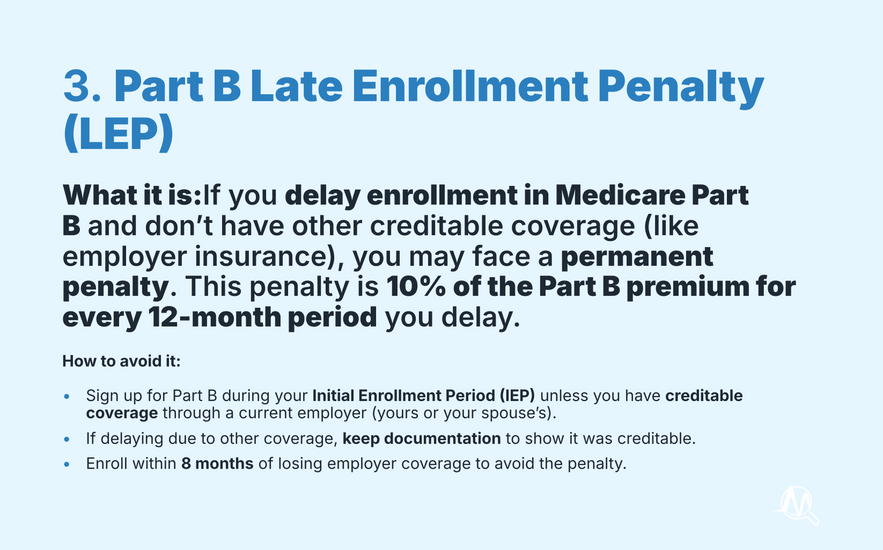Are You Aware of all the Possible Penalties, Rate Increases, and Premium Adjustments You Could Incur as a Beneficiary of Medicare? Do You Know How to Avoid Them?
- Brice

- Jul 28
- 3 min read
If you're preparing to enroll in Medicare Parts A and B — or if you've already signed up — you’re taking a major step toward securing your health coverage. But what many new beneficiaries don’t realize is that there are penalties, premium surcharges, and unpredictable rate increases that can significantly impact your costs over time.
Let’s break down what you need to watch out for and — more importantly — how to avoid unnecessary expenses.
1. IRMAA: Income-Related Monthly Adjustment Amount
What it is:IRMAA is a surcharge added to your Part B and/or Part D premiums if your income exceeds certain thresholds. The Social Security Administration bases this on your IRS-reported income from two years ago.
For example, if your modified adjusted gross income (MAGI) in 2023 was above $106,000 (individual) or $212,000 (joint filers), you'll pay more than the standard premium in 2025.
How to avoid or reduce IRMAA:
Plan ahead — consider Roth conversions or income-smoothing strategies before retirement
Appeal IRMAA — if your income dropped due to a qualifying life event (retirement, divorce, etc.), you can file Form SSA-44 to request a reduction
Review your tax filings — make sure your income is reported accurately
2. Medigap Rate Increases: Know the Pricing Models
What it is:Medigap (Medicare Supplement) plans help cover out-of-pocket costs from Parts A and B. While these plans are standardized in coverage, the way premiums increase over time is not.
There are three Medigap pricing models:
Community-rated: Everyone pays the same premium regardless of age
Issue-age-rated: Premium is based on your age when you enroll — doesn’t increase with age, but can go up due to inflation or other factors
Attained-age-rated: Starts lower, but increases as you age — often becomes the most expensive over time
How to avoid unexpected increases:
Ask about the pricing model before you enroll
If possible, choose community-rated or issue-age-rated plans for more predictable costs
Compare annual premium increase history with your agent or broker
Enroll during your Medigap Open Enrollment Period (6 months after enrolling in Part B) to avoid underwriting and lock in better rates
3. Part B Late Enrollment Penalty (LEP)
What it is:If you delay enrollment in Medicare Part B and don’t have other creditable coverage (like employer insurance), you may face a permanent penalty. This penalty is 10% of the Part B premium for every 12-month period you delay.
How to avoid it:
Sign up for Part B during your Initial Enrollment Period (IEP) unless you have creditable coverage through a current employer (yours or your spouse’s)
If delaying due to other coverage, keep documentation to show it was creditable
Enroll within 8 months of losing employer coverage to avoid the penalty
4. Part D Late Enrollment Penalty (LEP)
What it is:Delaying Part D (prescription drug coverage) without other creditable drug coverage will trigger a lifetime penalty. It’s 1% of the national base beneficiary premium ($36.78 in 2025) multiplied by the number of months you went without creditable coverage.
How to avoid it:
Enroll in a Part D plan during your IEP or when you lose other drug coverage
If you have other drug coverage, make sure it’s creditable and get proof from your plan provider
Keep that documentation in case Medicare asks for it later
Final Thoughts
Navigating Medicare is not just about choosing the right plan — it’s also about timing, documentation, and strategic planning to avoid unnecessary costs.
Here’s a quick recap of how to stay penalty- and surcharge-free:
Enroll on time — especially in Part B and Part D
Understand Medigap pricing models before choosing a plan
Monitor your income to prepare for or potentially reduce IRMAA
Keep proof of creditable coverage to avoid late penalties
A little planning today can save you a lot in the future. If you’re unsure about your timing or options, a licensed Medicare advisor can walk you through the details and help you make informed decisions.
















Comments